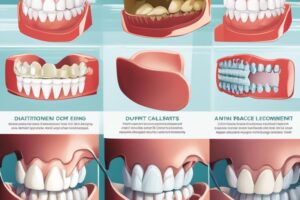Rural communities often face unique challenges when it comes to dental health compared to their urban counterparts. Limited access to dental care, shortage of dental health professionals, and poor oral hygiene practices are some of the prevalent issues in rural areas. These challenges can lead to higher rates of dental problems such as cavities, gum disease, and tooth loss. In contrast, urban areas tend to have better access to dental facilities and resources, resulting in lower prevalence of oral health issues.
Key Takeaways:
- Rural areas face challenges such as limited access to dental facilities, lack of oral health education, and lower socioeconomic status affecting affordability of care.
- Solutions for improving dental health in rural settings include mobile dental clinics, teledentistry, community outreach programs, and public health initiatives to increase awareness and access to care.
- Urban areas also have unique challenges like high population density leading to overcrowded clinics, higher costs of living affecting affordability, and increased prevalence of dental diseases due to urban lifestyle factors.
Dental Health Challenges in Rural Settings
Access to Dental Care
For many individuals living in rural settings, access to dental care is a significant challenge. Geographical distance from dental clinics and shortage of transportation options make it difficult for rural residents to visit a dentist regularly. Limited availability of dental clinics in rural areas further exacerbates this issue, leading to delayed or neglected dental treatment. As a result, preventable dental conditions can progress into more serious oral health problems.
Additionally, financial constraints often prevent individuals in rural areas from seeking dental care. Lack of insurance coverage for dental services and limited financial resources make it challenging for rural residents to afford regular dental check-ups and treatments. This financial barrier to dental care significantly impacts the overall oral health of individuals living in rural settings.
Workforce Shortages and Distribution
Access to dental care in rural settings is further hindered by workforce shortages and uneven distribution of dental professionals. Rural areas often face a shortage of dentists and dental hygienists, leading to inadequate availability of oral health services. The limited number of dental professionals choosing to practice in rural areas results in unequal distribution of oral health resources, leaving many rural communities underserved.
Challenges in recruiting and retaining dental professionals in rural settings include limited professional development opportunities, lower compensation compared to urban areas, and isolation from professional networks. These factors contribute to the ongoing workforce shortages in rural areas, making it difficult for residents to access vital dental care services.
Dental Health Challenges in Urban Settings
Unlike rural areas, urban settings face a different set of challenges when it comes to dental health. The Eight Ways to Mitigate US Rural Health Inequity may not directly apply in urban areas, but there are still significant obstacles to overcome.
Overburdened Health Systems
An overburdened health system in urban areas can significantly impact dental health access. With high population densities, there is often a shortage of dental professionals and resources to meet the demand. This leads to long wait times for appointments, limited preventive services, and a focus on emergency care rather than holistic dental health.
Socioeconomic Barriers to Care
The socioeconomic status of individuals in urban areas can create barriers to accessing dental care. Financial constraints and lack of adequate insurance coverage can prevent people from seeking regular dental check-ups and treatments. This results in untreated dental issues, which can escalate into more serious and costly problems over time.
Health disparities are prevalent in urban settings, with marginalized communities facing the brunt of the impact. Lack of education on the importance of oral health and limited access to affordable dental services contribute to widening inequalities in dental health outcomes.
Innovative Solutions to Address Dental Health Disparities
Policy Interventions and Programs
Addressing dental health disparities requires proactive policy interventions and the implementation of targeted programs. One crucial approach is the promotion of community water fluoridation, which has been proven to effectively reduce dental caries, especially in underserved areas. Additionally, governments can consider incentivizing dental professionals to practice in rural regions through loan repayment programs or scholarships. By increasing access to preventive care and education, these policies can help bridge the gap between rural and urban dental health outcomes.
Furthermore, creating partnerships between public health agencies, dental associations, and local community organizations can lead to the development of innovative programs that bring dental services to remote areas. Mobile dental clinics, school-based sealant programs, and teledentistry initiatives are all examples of interventions that can improve oral health access in rural settings and address disparities.
Technological Advancements and Tele-dentistry
One of the most promising avenues for addressing dental health disparities is through technological advancements and tele-dentistry. By utilizing digital platforms and remote communication tools, healthcare providers can offer virtual consultations, monitor patients’ oral health remotely, and provide education on preventive practices. This approach is particularly beneficial in rural areas where access to dental care is limited.
A key advantage of tele-dentistry is its ability to enhance patient engagement and continuity of care. Patients in remote areas can receive timely consultations and follow-up appointments without the need to travel long distances. Additionally, tele-dentistry can facilitate collaboration between dental professionals and primary care providers, leading to more comprehensive and coordinated healthcare services.
Bridging the Gap: Strategies for Improved Dental Health
Now, when it comes to improving dental health in both rural and urban settings, it is vital to implement strategies that can bridge the gap and address the unique challenges faced by each community. By focusing on community outreach and education, as well as integrating dental care into overall health services, we can work towards ensuring better oral health outcomes for all.
Community Outreach and Education
Strategies that involve community outreach and education play a vital role in promoting dental health. This approach involves partnering with local organizations, schools, and community centers to provide information on the importance of oral hygiene, proper brushing and flossing techniques, and the role of a balanced diet in maintaining healthy teeth and gums. By empowering individuals with knowledge, we can help prevent common dental issues and promote early intervention.
Integrated Health Care Models
Health care models that integrate dental services with primary health care have shown promising results in improving access to dental care, especially in underserved areas. By collocating dental clinics within existing health facilities or establishing mobile dental units that visit rural communities, individuals can receive comprehensive care that addresses both their dental and general health needs. This integrated approach not only improves convenience for patients but also promotes a holistic view of healthcare.
For instance, in some integrated models, dental professionals collaborate closely with primary care providers to address underlying health conditions that may impact oral health, such as diabetes or heart disease. This collaboration not only ensures that patients receive coordinated care but also enables early detection and management of conditions that could potentially worsen if left untreated. By addressing the link between oral health and overall health, integrated care models offer a comprehensive solution to improving dental health outcomes in both rural and urban settings.
Summing up
So, when it comes to dental health in rural vs. urban settings, there are unique challenges and solutions for each. Rural areas often face barriers such as limited access to dental care and lower oral health literacy, while urban areas may struggle with affordability and a higher prevalence of risk factors like sugary diets. To address these disparities, initiatives that focus on increasing access to care, improving education on oral hygiene, and promoting preventative measures like community water fluoridation are necessary. By recognizing and addressing the specific needs of each setting, we can work towards ensuring that everyone has access to the dental care they need for optimal oral health.
FAQ
Q: What are the challenges of dental health in rural areas compared to urban areas?
A: In rural areas, access to dental care is often limited due to a lack of dental facilities and professionals. Additionally, rural populations may face barriers such as transportation issues and a shortage of oral health education resources.
Q: How can we address the challenges of dental health in rural settings?
A: To improve dental health in rural areas, it is important to increase access to care through mobile dental clinics, telehealth services, and outreach programs. Providing incentives for dental professionals to practice in rural areas and expanding oral health education initiatives can also help address these challenges.
What are some solutions to improve dental health in both rural and urban settings?
A: Implementing community water fluoridation programs, promoting regular dental check-ups and preventive care, and raising awareness about the importance of oral hygiene are effective strategies to enhance dental health in both rural and urban areas. Collaboration between government agencies, healthcare providers, and community organizations is imperative in creating sustainable solutions for better dental health outcomes.







